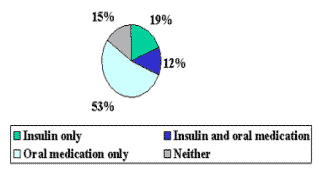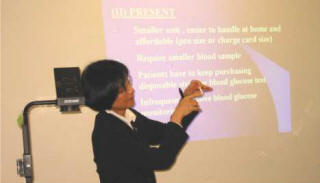Diabetes is the Nation’s 7th leading killer based on a 1998 statistical survey reported by Center for Disease Control showing 15.7 million Americans (5.9% of the U.S.A. population) afflicted with diabetes mellitus. Diabetes mellitus is classified as two main types, Type I and Type II. Type I is insulin-dependent and often occurs during
childhood or adolescence, Type II is insulin –independent with onset normally around age 40 or older.
Prevalence of Type II diabetes in men and women 20 years or older are reported to be 7.5 million (8.2% of all men) and 8.1 million (8.2% of all women), respectively and varies between different race and ethnic groups. Prevalence data for diabetes among Asian Americans and Pacific Islanders are limited. However, it is reported that data collected from 1988 to 1995 indicate that Native Hawaiians are twice as likely to have diagnosed diabetes as white residents of Hawaii. To disseminate information and educate people about diabetes, many educational programs have been provided by nationally based organizations such as Association of Asian/Pacific Community Health Organizations, National Asian Women’s Health Organization and many others. It is apparent from the data that it is in the national interest to diagnose, control and treat diabetes patients to minimize sequelae caused by diabetes and keep American people healthy.
For the past four decades many researchers have engaged in the development of glucose biosensors to test blood glucose levels to allow Type II diabetic patients to monitor glucose levels at home easily, quickly and accurately to better control their sugar levels. As a result smaller portable commercial sensors have become available that uses much less blood sample to test glucose levels. Amperometric glucose biosensors using enzyme, glucose oxidase and electron transfer mediators are an example.
More recently developments in materials science and technology have lead researchers to develop accurate, non-invasive and continuously monitoring glucose sensors, i.e. GlucoWatch monitor, that are easier and less painful for patients to use. It is expected these types of monitors will be commercially available in the very near future. We expect in the not distant future a devise will be developed that will monitor blood.
Dean Karan demonstrated the new glucose biosensors used in the measurement of blood sugar levels in diabetics. Even though it is a vast improvement over the older method of drawing blood from the vein, it still requires frequent pricking of the fingers.
Dean Karan listened intently to questions posed by the audience pertaining to the differences between Type I and Type II diabetes. The audience asked if diabetes developed after forty years of age could be transmitted to their offspring. Dean Karan answered by stating that it wouldn’t be considered hereditary if it weren’t genetically transmitted.
Diabetes
Updated September 15, 1998
- Diabetes mellitus is a disease caused by a deficiency of insulin, which is a hormone secreted by the pancreas.
- About 16 million Americans have diabetes, but only about 10 million have been diagnosed. Approximately 798,000 new cases of diabetes are diagnosed annually in the United States.
- The number of persons diagnosed with diabetes has increased sixfold, from 1.6 million in 1958 to 10 million in 1997. Diabetes is the nation’s seventh leading killer and contributed to about 187,800 deaths in 1995.
- Diabetes is classified into two main types: type 1 and type 2 . Type 1 diabetes (insulin-dependent), affects 5%-10% of those with diabetes and most often occurs during childhood or adolescence. Type 2 diabetes (non-insulin- dependent) is the more common type, affecting 90%-95% of those with diabetes. Type 2 diabetes usually occurs after age 40.
- Diabetes and its complications occur among Americans of all ages and racial/ethnic groups, but the elderly and certain racial/ethnic groups are more commonly affected by the disease. About 18% of Americans 65 years of age and older have diabetes.
- Diabetes patients risk debilitating complications such as blindness, kidney disease, and lower-extremity amputations.
- Cardiovascular disease is 2-4 times more common among persons with diabetes; the risk of stroke is 2-4 times higher; 60%-65% have high blood pressure; and 60%-70% have mild to severe diabetic nerve damage.
Source: http://www.cdc.gov/od/oc/media/fact/diabetes.htm

2002 National Diabetes Fact Sheet
General Information
What is diabetes?
Diabetes mellitus is a group of diseases characterized by high levels of blood glucose resulting from defects in insulin production, insulin action, or both. Diabetes can be associated with serious complications and premature death, but people with diabetes can take steps to control the disease and lower the risk of complications.
Types of diabetes
Type 1 diabetes was previously called insulin-dependent diabetes mellitus (IDDM) or juvenile-onset diabetes. Type 1 diabetes develops when the body’s immune system destroys pancreatic beta cells, the only cells in the body that make the hormone insulin that regulates blood glucose. This form of diabetes usually strikes children and young adults, who need several insulin injections a day or an insulin pump to survive. Type 1 diabetes may account for 5% to 10% of all diagnosed cases of diabetes. Risk factors for type 1 diabetes include autoimmune, genetic, and environmental factors.
Type 2 diabetes was previously called non-insulin-dependent diabetes mellitus (NIDDM) or adult-onset diabetes. Type 2 diabetes may account for about 90% to 95% of all diagnosed cases of diabetes. It usually begins as insulin resistance, a disorder in which the cells do not use insulin properly. As the need for insulin rises, the pancreas gradually loses its ability to produce insulin. Type 2 diabetes is associated with older age, obesity, family history of diabetes, prior history of gestational diabetes, impaired glucose tolerance, physical inactivity, and race/ethnicity. African Americans, Hispanic/Latino Americans, American Indians, and some Asian Americans and Pacific Islanders are at particularly high risk for type 2 diabetes. Type 2 diabetes is increasingly being diagnosed in children and adolescents.
Gestational diabetes is a form of glucose intolerance that is diagnosed in some women during pregnancy. Gestational diabetes occurs more frequently among African Americans, Hispanic/Latino Americans, and American Indians. It is also more common among obese women and women with a family history of diabetes. During pregnancy, gestational diabetes requires treatment to normalize maternal blood glucose levels to avoid complications in the infant. After pregnancy, 5% to 10% of women with gestational diabetes are found to have type 2 diabetes. Women who have had gestational diabetes have a 20% to 50% chance of developing diabetes in the next 5-10 years.
Other specific types of diabetes result from specific genetic conditions (such as maturity-onset diabetes of youth), surgery, drugs, malnutrition, infections, and other illnesses. Such types of diabetes may account for 1% to 5% of all diagnosed cases of diabetes.
Treating diabetes
- In order to survive, people with type 1 diabetes must have insulin delivered by injections or a pump.
- Many people with type 2 diabetes can control their blood glucose by following a careful diet and exercise program, losing excess weight, and taking oral medication.
- Many people with diabetes also need to take medications to control their cholesterol and blood pressure.
- Among adults with diagnosed diabetes, about 11% take both insulin and oral medications, 22% take insulin only, 49% take oral medications only, and 17% do not take either insulin or oral medications.
- Percent of adults with diagnosed diabetes treated by insulin and oral medications — United States, 1997-1999

Detailed information about this graph is available.
Impaired glucose tolerance and impaired fasting glucose
- Impaired glucose tolerance (IGT) and impaired fasting glucose (IFG) are considered to be prediabetic conditions, and studies suggest that they may be reversible.
- IGT is a condition in which the blood sugar level is elevated (between 140 and 199 milligrams per deciliter or mg/dL after a 2-hour oral glucose tolerance test), but is not high enough to be classified as diabetes.
- IFG is a condition in which the fasting blood sugar level is elevated (between 110 and 125 mg/dL after an overnight fast) but is not high enough to be classified as diabetes.
- Among U.S. adults 40-74 years of age, 16.0 million (15.6%) have IGT and 10.0 million (9.7%) have IFG.
Preventing diabetes
Research studies in the United States and abroad have found that lifestyle changes can prevent or delay the onset of type 2 diabetes among high-risk adults. These studies included people with IGT and other high-risk characteristics for developing diabetes. Lifestyle interventions included diet and moderate-intensity physical activity (such as walking for 2 1/2 hours each week). For both sexes and all age and racial and ethnic groups, the development of diabetes was reduced 40% to 60% during these studies that lasted 3 to 6 years.
Studies have also shown that medications have been successful in preventing diabetes in some population groups. In the Diabetes Prevention Program, a large prevention study of people at high risk for diabetes, people treated with the drug metformin reduced their risk of developing diabetes by 31%. Treatment with metformin was most effective among younger, heavier people (those 25-40 years of age who were 50 to 80 pounds overweight) and less effective among older people and people who were not as overweight.
There are no known methods to prevent type 1 diabetes. Several clinical trials are currently in progress.

Preventing diabetes complications
Glucose control
Research studies in the United States and abroad have found that improved glycemic control benefits people with either type 1 or type 2 diabetes. In general, for every 1% reduction in results of A1C blood tests, the risk of developing microvascular diabetic complications (eye, kidney, and nerve disease) is reduced by 40%.
Blood pressure control
- Blood pressure control can reduce cardiovascular disease (heart disease and stroke) by approximately 33% to 50% and can reduce microvascular disease (eye, kidney, and nerve disease) by approximately 33%.
- In general, for every 10 millimeters of mercury (mm Hg) reduction in systolic blood pressure, the risk for any complication related to diabetes is reduced by 12%.
Control of blood lipids
- Improved control of cholesterol and lipids (for example, HDL, LDL, and triglycerides) can reduce cardiovascular complications by 20% to 50%.
Preventive care practices for eyes, kidneys, and feet
- Detecting and treating diabetic eye disease with laser therapy can reduce the development of severe vision loss by an estimated 50% to 60%.
- Comprehensive foot care programs can reduce amputation rates by 45% to 85%.
- Detecting and treating early diabetic kidney disease can reduce the development of kidney failure by 30% to 70%.


